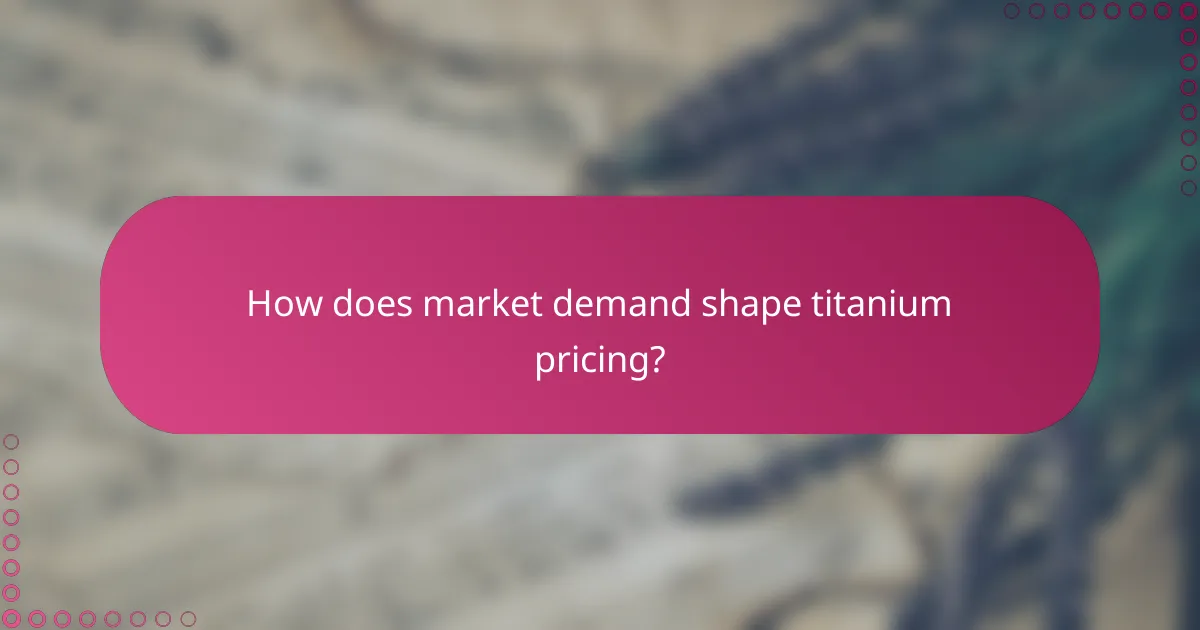Titanium pricing is shaped by several key factors, including extraction costs, the presence of alloying elements, and overall market demand. Extraction costs encompass various elements such as mining methods and energy expenses, which directly impact the price of raw titanium. Additionally, the choice and proportion of alloying elements can alter production processes and material properties, further influencing market dynamics.

What factors influence titanium pricing in the USA?
Titanium pricing in the USA is primarily influenced by extraction costs, the presence of alloying elements, and market demand. Understanding these factors can help buyers and sellers navigate fluctuations in titanium prices effectively.
Extraction costs
Extraction costs are a significant determinant of titanium pricing. These costs encompass the expenses associated with mining and processing titanium ore, which can vary based on the location and technology used. For instance, the costs can range from low tens of dollars to higher amounts per ton depending on the ore quality and extraction methods.
Additionally, environmental regulations and labor costs in the USA can further impact extraction expenses. Companies must comply with various regulations, which can add to the overall cost structure.
Alloying elements
The presence of alloying elements in titanium can significantly affect its price. Elements such as aluminum, vanadium, and molybdenum are commonly added to enhance specific properties like strength and corrosion resistance. The cost of these alloying elements fluctuates based on market conditions, which can directly influence the final price of titanium alloys.
For example, if the price of aluminum rises due to increased demand in the aerospace sector, the cost of titanium alloys containing aluminum will likely increase as well. Buyers should consider these factors when evaluating titanium pricing.
Market demand
Market demand plays a crucial role in determining titanium prices. Industries such as aerospace, automotive, and medical devices are significant consumers of titanium, and their demand can lead to price fluctuations. When demand surges, prices often increase, while a decrease in demand can lead to lower prices.
Monitoring trends in these industries can provide insights into potential price movements. For instance, a new aerospace project requiring titanium components may drive up demand and, consequently, prices.
Geopolitical influences
Geopolitical factors can significantly impact titanium pricing. Political stability in titanium-producing regions, trade policies, and tariffs can all affect supply and, subsequently, prices. For example, sanctions on a major titanium producer could disrupt supply chains, leading to price increases in the USA.
Buyers should stay informed about global political developments that could influence the titanium market, as these changes can have immediate effects on pricing.
Supply chain logistics
Supply chain logistics are critical in determining the final price of titanium. Factors such as transportation costs, lead times, and inventory management can all impact pricing. For instance, disruptions in shipping routes or increased fuel prices can raise transportation costs, which are then passed on to consumers.
Effective supply chain management can help mitigate some of these costs. Companies that maintain strong relationships with suppliers and optimize their logistics can better manage price fluctuations in titanium.

How do extraction costs affect titanium prices?
Extraction costs significantly influence titanium prices by determining the overall expense of obtaining the raw material. Factors such as mining methods, energy costs, and labor expenses all contribute to these extraction costs, ultimately impacting market pricing.
Mining methods
The method of mining titanium can vary widely, affecting both efficiency and cost. Open-pit mining is commonly used for titanium extraction, as it allows for the removal of large quantities of ore at a lower cost. However, more advanced techniques, such as underground mining, may be necessary in certain locations, which can increase extraction costs significantly.
Additionally, the choice of mining method can impact environmental regulations and compliance costs, which may further influence overall pricing. Companies must balance the benefits of different methods against their associated costs and regulatory requirements.
Energy costs
Energy costs are a critical component of titanium extraction expenses, as the process requires significant amounts of power for operations such as ore processing and smelting. Fluctuations in energy prices, particularly for electricity and fossil fuels, can lead to substantial variations in overall extraction costs.
For instance, regions with higher energy prices may see increased titanium prices due to the added costs of extraction. Companies often seek to optimize energy use through efficiency measures or by exploring renewable energy sources to mitigate these costs.
Labor expenses
Labor expenses play a vital role in determining the extraction costs of titanium. Skilled labor is necessary for the operation of mining equipment and processing facilities, and wage levels can vary significantly by region. Areas with higher labor costs may experience increased titanium prices as companies pass on these expenses to consumers.
Additionally, labor regulations and the availability of skilled workers can impact operational efficiency and costs. Companies should consider local labor market conditions when planning extraction operations to ensure they remain competitive in pricing.

What role do alloying elements play in titanium pricing?
Alloying elements significantly influence titanium pricing by affecting extraction costs, production processes, and the final material properties. The choice and proportion of these elements can lead to variations in market demand and pricing strategies.
Common alloying elements
Common alloying elements in titanium include aluminum, vanadium, and molybdenum. Aluminum is often used to enhance strength and reduce weight, while vanadium improves toughness and corrosion resistance. Molybdenum can increase high-temperature strength, making it valuable for aerospace applications.
The specific combination of these elements can vary based on intended use, affecting both the material’s performance and its cost. For example, titanium alloys with higher aluminum content may be less expensive due to lower extraction costs compared to those with rare or expensive elements.
Impact on material properties
Alloying elements directly impact the mechanical and physical properties of titanium. For instance, aluminum increases the alloy’s strength-to-weight ratio, making it suitable for aerospace and automotive industries. Conversely, adding vanadium can enhance ductility, which is crucial for applications requiring deformation without fracture.
These changes in properties can lead to significant differences in pricing. Alloys that offer superior performance in demanding environments often command higher prices due to increased demand and specialized production processes. Understanding these impacts helps manufacturers and buyers make informed decisions regarding material selection and cost management.

How does market demand shape titanium pricing?
Market demand significantly influences titanium pricing by affecting extraction costs and the availability of alloying elements. When demand increases, prices typically rise due to higher competition for limited resources and production capacities.
Industry applications
Titanium is widely used across various industries, including aerospace, automotive, medical, and chemical processing. Its strength-to-weight ratio and corrosion resistance make it ideal for applications such as aircraft components, surgical implants, and chemical reactors. As industries evolve and seek lighter, stronger materials, the demand for titanium continues to grow.
In the medical field, titanium’s biocompatibility has led to its use in implants and prosthetics, further driving demand. The automotive sector also increasingly incorporates titanium in high-performance vehicles to enhance fuel efficiency and reduce weight.
Trends in aerospace and automotive sectors
The aerospace sector is a major consumer of titanium, with demand driven by the need for lightweight materials that can withstand extreme conditions. As airlines focus on fuel efficiency and sustainability, the use of titanium in aircraft design is expected to rise, impacting pricing positively.
In the automotive industry, the trend towards electric vehicles (EVs) is increasing the use of titanium for components such as battery housings and structural parts. This shift not only boosts demand but also influences pricing as manufacturers adapt to new technologies and materials.

What are the prerequisites for evaluating titanium pricing?
To evaluate titanium pricing effectively, one must consider extraction costs, the influence of alloying elements, and current market demand. Understanding these factors will provide a clearer picture of how titanium prices fluctuate and what drives those changes.
Understanding titanium grades
Titanium is categorized into several grades based on its purity and alloying elements, which significantly affect pricing. Common grades include commercially pure titanium (CP) and various titanium alloys, each suited for specific applications in industries like aerospace and medical. For instance, CP titanium is generally less expensive than titanium alloys that contain elements like aluminum or vanadium.
The pricing of titanium grades can vary widely, often ranging from low tens of USD per kilogram for CP grades to higher prices for specialized alloys. Buyers should assess the specific requirements of their projects to choose the appropriate grade that balances cost and performance.
Market research resources
Conducting thorough market research is essential for understanding titanium pricing trends. Key resources include industry reports, market analysis publications, and databases that track commodity prices. Websites like MetalMiner and the London Metal Exchange provide valuable insights into current market conditions and pricing fluctuations.
Additionally, networking with suppliers and attending industry conferences can yield firsthand information about pricing strategies and emerging market trends. Staying informed about global supply chain issues and geopolitical factors can also help anticipate changes in titanium pricing.

What are the emerging trends in titanium pricing?
Emerging trends in titanium pricing are heavily influenced by factors such as recycling practices, technological advancements, and fluctuating market demand. As sustainability becomes a priority, the industry is adapting to these changes, affecting extraction costs and alloying elements.
Recycling and sustainability
Recycling titanium is gaining traction as a way to reduce costs and environmental impact. Recycled titanium can be significantly cheaper than newly extracted titanium, often costing around 30-50% less. This shift not only lowers prices but also aligns with global sustainability goals.
Companies are increasingly investing in technologies that enhance the efficiency of titanium recycling processes. The use of recycled materials can help meet the growing demand for sustainable practices, making it a key factor in future pricing trends.
Technological advancements
Technological advancements in titanium extraction and processing are reshaping the market landscape. Innovations such as improved extraction methods and more efficient alloying techniques can lower production costs, which may lead to more competitive pricing. For instance, advancements in 3D printing technology are enabling the use of titanium in new applications, driving demand.
Additionally, the development of new alloys and composites can enhance the properties of titanium, making it more appealing for various industries. As these technologies mature, they are likely to influence both the supply chain and pricing structures in the titanium market.


